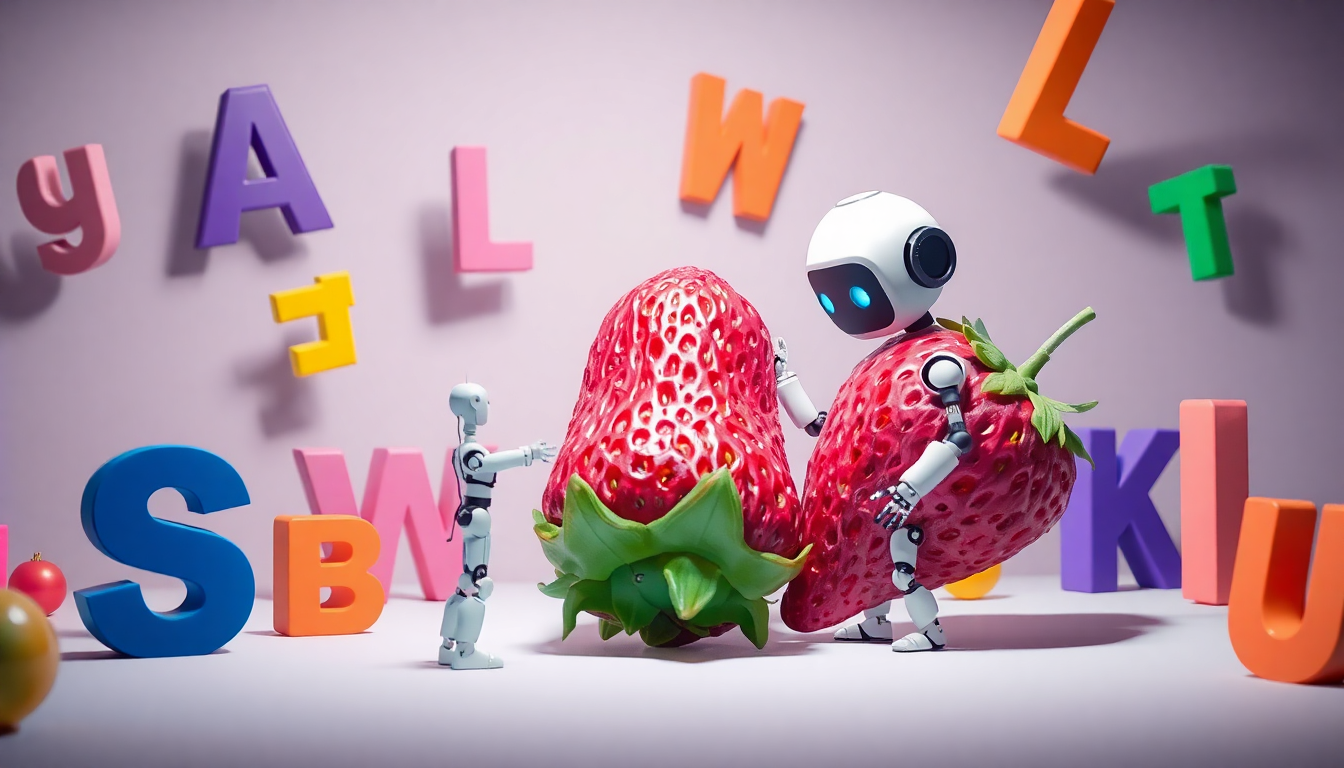AI's Strawberry Problem: Why Smart Machines Can’t Count Simple Letters
Artificial Intelligence is like that overachieving classmate who can solve complex calculus problems but struggles with the basics. And nothing embodies this paradox quite like AI’s strawberry problem. You see, despite its prowess in analyzing vast datasets, generating creative writing, and outpacing human champions at Go, AI fumbles when asked to count the number of “r”s in “strawberry.”
No joke. This high-tech wizardry can help optimize supply chains and predict stock market fluctuations, but it’s hilariously stumped when asked how many “r”s are in a common fruit's name. It’s not just strawberries, either—AI falters at counting “m”s in “mammal” and “p”s in “hippopotamus.” So, what gives?
Let’s peel back the layers of this AI quirk, understand why it happens, and discover how a deeper look at AI’s limitations can actually give us a clearer vision for its potential.
The Source of the Problem: Transformers and Tokens
Why AI Struggles With the Basics
Let’s start with why AI can’t count letters. Most advanced language models like ChatGPT (courtesy of OpenAI) and Claude (developed by Anthropic) are built on something called transformers. These are deep learning architectures designed to process vast amounts of data by breaking it down into tokens—which are essentially numerical representations of words, parts of words, or even entire phrases.
But herein lies the issue. These AI models don't process letters like humans do. For instance, instead of understanding "strawberry" as a string of individual characters, it sees "strawberry" as one or more tokens that represent larger chunks of the word. It might split “hippopotamus” into chunks like “hippo,” “pot,” and “amus” instead of analyzing each letter individually.
In essence, the AI is more concerned with understanding the meaning of words and predicting what comes next in a sentence than paying attention to how many “p”s or “r”s are in those words. It’s like asking a world-class chef to count sprinkles on a cupcake—sure, they could do it, but it’s not what they were trained for.
Tokens: AI’s Favorite Building Blocks
The AI's misunderstanding comes down to how it processes language at its core. These systems break down language into tokens so that they can more easily handle massive amounts of data. The problem is, tokens are designed to preserve meaning, not structure. In the case of "strawberry," it might tokenize the word as a whole, missing the finer details like counting specific letters.
And let’s be real: It’s not computationally feasible for most transformer models to focus on every individual letter when they’re being asked to handle a gazillion other tasks at the same time. So, AI skips over this kind of minutiae. Sure, it can generate poetry that moves you to tears, but it’ll guess at how many “r”s are in a word and be way off.
Why It Matters: AI's Real-World Implications
The Bigger Picture: From Strawberries to Healthcare
You might be thinking, “Why should I care if AI can’t count letters?” Fair question. After all, we aren’t paying these models to be glorified spelling bees. But this quirky little problem is just the tip of the iceberg. It exposes a fundamental limitation of AI's architecture and shows how, despite their dazzling capabilities, AI systems still operate in a fundamentally different way from human intelligence.
Imagine you’re using AI in a hospital to identify tumors on medical scans. If the AI system can’t generalize across different images or variations it hasn’t seen before, it could miss life-threatening anomalies. What happens when AI faces an out-of-distribution example that doesn’t quite match its training data—just like an unexpected variation of a strawberry? The consequences could be dire.
This problem isn’t just about letter counting—it’s a spotlight on how AI still struggles with situations outside its pre-defined knowledge, whether that’s a fruit dipped in chocolate or a new strain of virus that doesn’t fit the usual pattern.
Bias in the Data: The Dark Side of AI
Beyond strawberries and spelling issues, there’s a darker side to AI’s tokenization approach: bias. Since AI models learn from the data they're trained on, they can easily pick up on and amplify the biases present in that data. This is why facial recognition technology, for instance, has faced criticism for being less accurate when identifying people of color. When AI tokenizes everything based on the patterns it's learned from often biased datasets, it can reinforce systemic issues rather than help solve them.
So, yeah—it’s funny when an AI flubs counting the “r”s in "strawberry," but it’s a wake-up call when we consider how this same technology is making real-world decisions about hiring, policing, and healthcare.
Solving the Problem: Making AI Smarter (And Less Stupid)
Multimodal Learning: Teaching AI to "See" Like Humans
One promising approach to fix this issue is multimodal learning. Instead of only relying on text data, multimodal AI systems process different types of information—text, images, sound—much like humans do. So instead of just reading about strawberries, AI would “see” a strawberry in all its variations, adding context and nuance to its understanding.
By combining different modes of learning, AI could develop a more holistic grasp of the world. It would understand that a strawberry can be red, squished, dipped in chocolate, or even half-eaten by a toddler—and still be a strawberry.
Self-Supervised Learning: The Future of AI Cognition
Another way to make AI smarter is through self-supervised learning, which lets AI learn from unlabeled data and make its own connections. Think of it like a kid figuring out the world on their own, without an adult constantly telling them what’s what. The AI would learn to recognize patterns on its own terms and wouldn’t need to be spoon-fed every variation of a strawberry or mammal.
Human-in-the-Loop: Bridging the Gap
Finally, there's the concept of human-in-the-loop learning, where humans guide AI systems, correcting them when they make mistakes and giving them feedback on tricky cases. This hybrid approach ensures AI keeps improving and doesn’t get stuck in the same pattern-matching rut. Think of it like training wheels for AI—it’s learning, but with a little help from its human friends.
The Quirky, the Dystopian, and the Hopeful Future of AI
AI’s failure at counting letters might seem trivial, but it opens up bigger questions. What does it mean when machines, which we’ve entrusted to make critical decisions, can’t grasp simple tasks? And as we charge headlong into an AI-powered future, what kinds of limitations are we comfortable with? AI can’t yet think like humans, but with advancements in multimodal and self-supervised learning, it’s possible we’ll one day overcome these shortcomings.
Still, AI’s limitations serve as a necessary reminder that while it can simulate intelligence, it’s not truly thinking. It’s great at pattern-matching and predicting—but not reasoning. And recognizing this truth will be essential as AI becomes more deeply woven into our lives.
So, let’s keep AI in check. Just because it can answer complex questions doesn’t mean it’s infallible. As we move forward, we must continue to ask ourselves: What role should AI play, and how do we ensure it works for us—not against us?
Lessons From the Strawberry Problem
If there’s one takeaway from the strawberry problem, it’s that AI is still a long way from human cognition. Sure, it can ace the big tasks, but the small, everyday problems—the ones that require adaptability and intuition—continue to trip it up. AI is a tool, and like all tools, it has its limits. The challenge moving forward is learning how to work within those limits and design systems that compensate for them.
What do you think? Are these quirks endearing or concerning? Will AI ever truly understand the world the way we do? Let me know your thoughts in the comments below.
And hey, if you’re as fascinated by the potential of AI as I am, why not become a part of the iNthacity community? Apply to become permanent residents, then citizens of the “Shining City on the Web”, and let’s shape the future together.



















Post Comment
You must be logged in to post a comment.